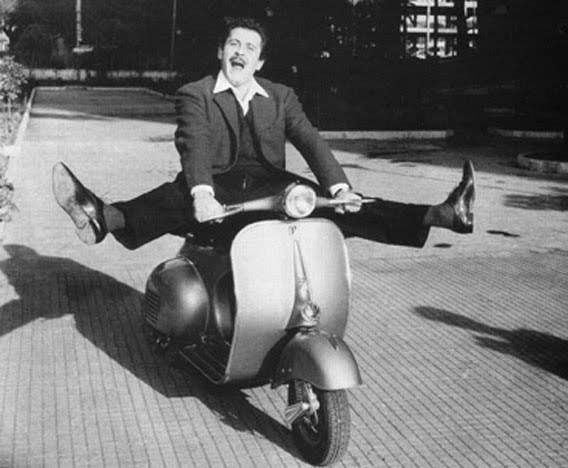
SOCIETY AND CUSTOMS
From 1861 to 1900 Italy was marked by poverty, backwardness and despair. Then after the first World War the bases of a trade development were provided; but it was after the second World War that economic growth and innovative transformations were carried out.

The economic boom covered the years between 1957 and 1963. It mainly affected the industral sector through the manufacture of new goods of mass production and the use of new technologies. There was a significant decrease in the number of workers in the primary sector, but a constant increase in the employment of workers in the secondary and tertiary sectors. There was also a demand for consumer goods such as clothing or electrical appliances. This phenomenon known as "economic miracle" involved all levels of society. It was favoured by the growing number of the polpulation that was better educated and could have better jobs.
1) MORE LIBERAL POLICIES: De Gasperi's Government;
2) LOW COST OF LABOUR FORCES: Due to high
levels of unemployment;
3) BIG INVESTMENT IN SOME STRATEGIC SECTORS (e.g steel industry)
4) ITALY ENTERED THE EEC: This encouraged
an open economy by increasing export;
5) BIRTH OF LOCAL GOVERNMENT WHICH INVESTED IN SOCIAL SERVICES: (creche, rest homes);
1) ECONOMIC TRANSFORMATION: it was a radical economic change characterized by the shift from an agricultural and backward economy to an industrialized one;
2) EDUCATION: its purpose was to abolish illiteracy;
3) TEENAGERS: recognized as social subjects;
4) MORE EMPLOYMENT: it stepped up the national income and boosted the living standards
5) SOCIAL ECONOMIC GAP BETWEEN THE NORTH AND THE SOUTH: internal migration from the South to the North, from the countryside to towns;
6) WOMEN'S LIBERATION: women were granted the right to work and to have the same rights as men;
7) SICKNESS BENEFITS: thanks to a better health service.
THE EMANCIPATION OF WOMEN

1) As mothers and housewives;
2) same rights as men;
3) wage equality;
4) women gained the right to work in public offices.
YOUNG GIRLS

1) They had new chances of social success;
2) Higher numbers of fermale students;
3) New female jobs as flight attendants, interpreters, models, beauticians.
FASHION

1)Over blouse, high waist trousers, tight sweaters, flat shoes;
2)Hair was cut with a bang and boys wear their hair long;
3)Invention of the miniskirt.
TEENAGERS
Teenagers were the result of the economic boom as before the war the distinction was just between children and adults. It was in 1959 that the "youth question" started to attract the attention of the entire adult world which was deeply concerned about the social behavior of young people.

Young people, in fact, had started to strive for their own cultural identity because of different factories, that is:
1) a new and developed production system, which allowed them to have more money available to spend;
2) the increased level of education, which offered teenagers the opportunity to spend more time with peers, developing attitudes and tastes in common;
All this encouraged teenagers to buy new consumption goods, such as jeans, rubber shoes, black leather jackets, means of transport (Lambrettas), vinyl records, and foods, such as coke, whiskey and soda, burgers and things of the kind.
CONSUMPTION GOODS WITHIN THE FAMILY
New consumption goods such as the fridge, the washing maschine, the record-player, the radio, the car, products of the economic boom, brought about changes in the Italian household. The fridge, for instance, made it possible to preserve food much longer, the washing machine to wash clothes quicker thus improving cleanliness and domestic life in general.




TELEVISION
Television played an important role in the economic boom years, since it had a strong educational function, contributing to:
1) the growth of the national language;
2) the spread of great literary classics;

It underwent a lot of changes, but we'd like to focus on "CAROSELLO", first broadcast on Rai 1 (Channel 1) in 1957.
It advertised products using catchy slogans and entertaining sketches.
It kept millions of children glued to the TV set and affected youth culture as well.
And after "Carosello" children had to go to bed! (as the saying went).
Among the well-known and beloved characters launched by "Carosello" we'd like to mention CALIMERO, a tiny black chick that turned completely white after being washed with the famous detergent "AVA" (AVA COME LAVA!)

Television played a fundamental role in the advertising market which involved all social classes.
The products advertised were presented as essential to efficient and modern houses and became real objects of desire, the new status symbol.
MASS CONSUMERISM AFFECTED DIFFERENT SECTORS:
1) ENTERTAINMENT (Holidays)



2) MASS MEDIA
a)CINEMA:
-It developed American myths and icons;
-It transmitted images, stories, cultural ideas, literary, historical and artistic traditions of our country;



b) RADIO:
- It became an important means of political information and communication;
- It broadcast behaviours and customs;
-It smoothed out behaviours, local languages, uses and customs of the Italian population.



c) TV



3) SHOPPING (Supermarkets)



Written by:
Raffaella Prencipe
Claudia Silini
Sara Zanesi



No comments:
Post a Comment
Note: only a member of this blog may post a comment.